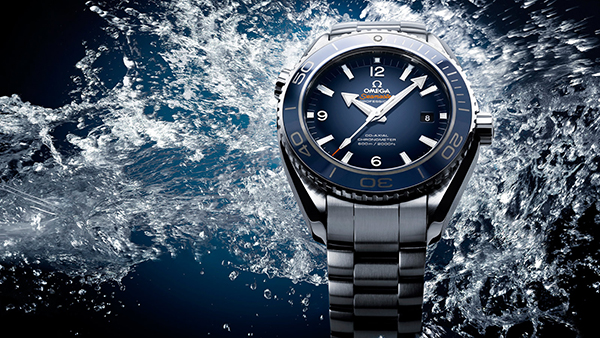What to Do When You Get Water in Your Watch
Some watches are renowned for their water resistance: the Rolex Submariner, for example, is water resistant to 984 feet (300 meters), making it great for a deep dive underwater. However, when used incorrectly, even a watch like the Submariner can let in water and suffer water damage, because, in truth, no watch is truly waterproof. If you suspect that your watch has suffered from water damage, then this post is for you. We’ve answered your questions about what to do when you get water in your watch.
What does water damage look like on a watch?
The biggest clue to the existence of water inside a watch’s case is condensation. If the crystal on the watch’s face has droplets of water or dew on the inside, then the watch has lost its water resistance and is retaining some water inside the case, and likely, inside the movement. This can be a problem since the water can make the metal elements inside the watch get rusty. If the water is saltwater or has other kinds of particles in it (algae, soap, etc.), that could prove to be even worse, as the insides of watches are very sensitive, and these other particles can corrode the metal and irreparably damage the watch.
More clues to water damage could be broken lumes or malfunctioning hands. If lumes on the hands, markers, or other parts of the dial have stopped glowing in the dark inexplicably, then that might be indicative of water seeping into these features and destroying them. Malfunctioning hands that stutter or stop entirely are symptomatic of a broken movement, which could have been corroded or misplaced by water inside the watch.

I thought my watch was waterproof. What happened?
Like we said, no watch is ever truly waterproof, which is why they’re actually marketed as water-resistant. Water-resistant watches, no matter how resistant they are to water and pressure, can lose their resistance over time because these watches tend to depend on an O-ring, which is a gasket that goes around the crown of the watch and acts as a seal against water. Because the O-ring is often made of rubber or silicon, it starts drying out as soon as it leaves the factory, and when it does, it shrinks and hardens up, leaving the watch susceptible to water damage. This can take months or even years, but it does happen.
The watch’s water resistance could also have been compromised by misuse. If you have a diving watch with a rotating bezel and two pushers in addition to the crown, for example, your watch has several openings through which water can enter the case. You need to make sure that the crown and pushers are properly screwed in tight and that the rotating bezel is set before you enter or go near water. If the bezel is rotated underwater or the crown or pushers are not properly pushed in, water will enter the watch.

So my watch has water damage…what do I do now?
You have two options here: either leave the watch out to dry or bring it to a watchmaker to have it repaired.
If you know that the water has not been in the watch for very long, like, say, a day or two, and that there isn’t much of it inside the watch, then you should be fine if you left the timepiece out to dry. One way to do so is to place the watch caseback side down on a radiator, a lamp, or in a sunny spot on a window sill. This will draw the moisture away from the movement and heat the watch up a little bit so that the water dries faster. Be careful with this method, though, because the watch could suffer heat damage if left in the heat to dry for too long or if the surface it’s on gets too hot. Keep a careful eye on the watch.
Another way to let the piece dry is to carefully submerge it in a desiccant, which is a substance that will wick away the moisture and absorb it. Dry, uncooked rice is a popular option—in fact, people who have submerged their smartphones in water tend to leave their devices in rice to dry out. Another is to use clean cat litter: the white, pure silica gel kind works better, but the kind with gray clay in it is acceptable, too.
Whether you leave the watch in the heat to dry or submerge it in a desiccant, be sure to leave it flat and caseback-side down so that it faces up at you. This way, gravity will have a hand in getting the moisture out of the watch, too.
If the damage is extensive, a trip to a reputable watchmaker will be necessary. In general, no matter the level of water damage of the watch, we highly recommend bringing the timepiece to a watchmaker for repair as soon as possible.
In severe cases especially, the watch should be brought to a watchmaker (not a jeweler) so that they may take it apart safely and dry each individual piece out of the over 100 pieces that go into the structure of a watch. They will then put each piece in a cleaning machine to ensure that any residue will be cleaned off, and then they will repair or replace the pieces that have suffered water damage.

How can I prevent my watches from suffering from water damage in the future?
Preventative measures can definitely be taken to avoid water damage in the future! First of all, pay attention to the water resistance that the manufacturer recommends for your specific watch model. Every model is different, and, on top of that, the water resistance levels can be a little misleading, since the measurements watchmakers use only take pressure into account, not necessarily water depth. We’ve put together this graph to help you figure out how water resistant your timepiece actually is:

In addition to following this guide for how much pressure your watch can take, you should also take it in to a watchmaker for water resistance testing. New models should go in every year and should not be allowed to go more than 2 full years without resistance testing. Vintage models tend to warp and get more brittle over time and should be taken in at least once a year for testing. The watchmaker conducting these tests can then replace or repair any piece of the watch’s construction that may compromise its water resistance.
Finally, of course, it’s paramount that you read over the watch’s manual and make sure to make proper use of all its complicated features before you bring the timepiece into a body of water.







